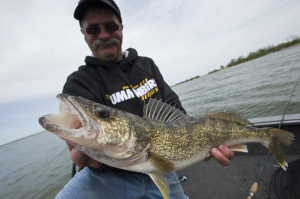Post
When to use rattling crankbaits
Freshwater Fishing Tips, Tackle Tips & How To's theangler PM

When it comes to walleyes, typically, I find they react more positively to subtler rattles. This drumbeat plays particularly well in darker water, amidst weed growth and submerged timber, and where rocks form the structural baseline. A fish’s instinctive reaction in these situations is more impulsive than a program of stalking and striking.
At this point it’s prudent to note, too, that crankbaits without any rattle supplements still produce sound. For years I wondered what sort of sound a Rapala Shad Rap emitted. It wasn’t audible in the palm of my hand, but there was some type of clicking going on underwater. Upon closer examination, I realized that each bait has small grooves where the treble hook bangs against the body as it wobbles. The split rings that attach the treble hooks add to the percussion. That, and as the bill pushes water, it, too, generates an audible signal. So in reality, there is no such thing as a silent crankbait.
The sound multiplier continues as the crankbait comes into contact with objects. Ripping through weeds causes both visual and audible commotion. The bill banging off boulders and softer thudding against wood can’t be ignored, either.

Two famous Minnesota Twins, the Glorvigan Brothers, Scott and Marty, turned my head several years ago when they were catching monster walleyes burning lipless crankbaits with rattle chambers over the tops of cabbage weeds in the heat of the summer. The strikes were wicked and they were catching walleyes when others were just wishing. It opened my eyes again to the importance of sound in certain situations. Baits like the classic Rapala Rattlin’ Rap and new Rippin Rap beg, or maybe dare fish to blow up out of the weeds. In general, the heavier the cover the more turmoil you need to create.
Open water trolling is one place that built-in rattles can make a huge difference. Most often when trolling large swaths of water and suspended walleyes are on the radar, baits with rattles can attract roaming walleyes. In such cases, I run Glass Shad Raps, Husky Jerks and the Troll-To Minnows – each features a unique, but not overwhelming sound.
And by “radar,” I’m really talking about Humminbird’s advanced Side Imaging. Literally, I can spy walleyes 100-feet away to starboard and port, not to mention those delicious golden arcs below. Once identified with Side Imaging, I’ll drop a waypoint on the walleyes and come back trolling right through the money zone.
For trolling crankbaits, I switch to an 8 to 8 1/2 foot length rod to cushion the shock and not pull hooks once a fish is on. Daiwa’s Line Counter Series take control of my line and fishing destiny on the troll. My choice is either the Sealine SG17 or Accudepth AD17. Both let me consistently control how much line goes out, and subsequently the depth crankbaits run.
If you’re a gamer and want to take advantage of the precision trolling offered by leadcore line, consider Sufix 832 Lead Core. The metered line is narrower diameter than the cumbersome old fashioned styles. As a result, the bait dives to the prescribed zone with less line out. That, and you can actually enjoy the true fight of the fish. Combine ancient leadcore with a lesser sized walleye and the entertainment value drops. I’d rather soak a sucker minnow off the dock than drag in fish you can’t even feel.
Noisemaker crankbaits deserve their day in court, and chance to produce in your boat. But always remember that even so-called traditional, or non-rattling crankbaits generate sound. And oftentimes the subtler amplitude is what summons success.
